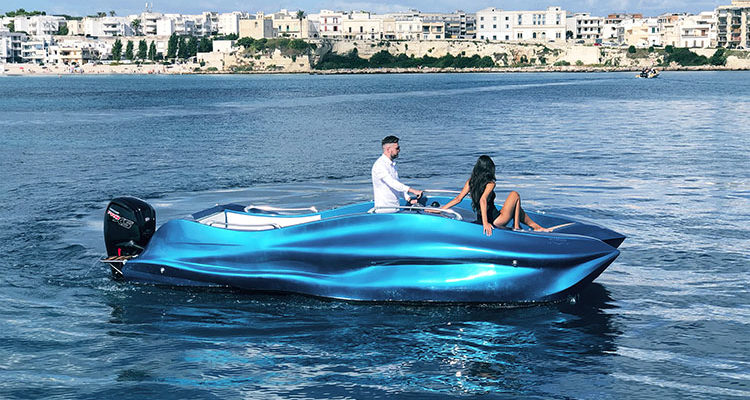Once completed, the parts were joined and laminated at Catmarine shipyard in Lecce, Italy. The components were first glued together into seven sections. Each section was then laminated with GFRP fabrics, polyester resin and a PVC core using hand lay-up. The entire structure was then laminated again to create a one-piece sandwich structure without hull-deck division. No fasteners were used. After curing, the hull received a gel coat and the deck was painted a vibrant blue, metallic color.
“I think one of the biggest challenges we had was how to assemble the final structure,” says Natale. “That was really complicated. We had to imagine a way to join all the parts together and laminate all the sections together in a way that was strong enough to create a boat – a real boat – that was deployable in the sea.”
As of February 2021, MAMBO had logged approximately 100 hours on the water at speeds of up to 25 knots. Once coronavirus boating restrictions are lifted, Moi plans to move the MAMBO to Milan or Lake Como and use it regularly. In the meantime, the firm is already planning for MAMBO 2.0.
 “We gained a lot of knowledge about this kind of boat construction, and already have some ideas that can improve the next version of the boat,” says Natale. For instance, the company has experimented with printing the sandwich structure directly using the robotic arm to save production time and maximize performance. Ultimately, Moi hopes to produce one-of-a-kind boats using mass customization. Allowing customers to create their own personal boat model will free up designers to push the design envelope.
“We gained a lot of knowledge about this kind of boat construction, and already have some ideas that can improve the next version of the boat,” says Natale. For instance, the company has experimented with printing the sandwich structure directly using the robotic arm to save production time and maximize performance. Ultimately, Moi hopes to produce one-of-a-kind boats using mass customization. Allowing customers to create their own personal boat model will free up designers to push the design envelope.
“The creativity of many designers today is suppressed due to various factors – technological, geometric limits or production costs. And there are countless noteworthy projects destined to remain magnificent renderings forever,” says Natale. “However, with CFM technology these designs can become real.”


